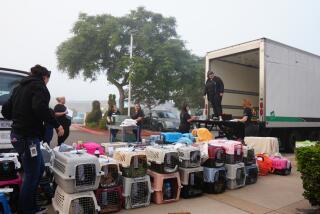Starving Wildlife Shot to Feed Zimbabwe
BENJI WIER, Zimbabwe — Swaying unevenly, a starving bull elephant heads for a drying water hole reduced to glutinous black mud. Another elephant, too weak to drag itself free, has died knee-deep in the mire.
As southern Africa suffers its worst drought this century, thousands of animals have died and officials are shooting many more to feed the increasingly desperate population.
About 10,000 hungry villagers near the Gona-Re-Zhou national park in southeastern Zimbabwe are being fed meat from animals who have been herded into corrals and slaughtered with assault rifles.
Zimbabwe was one of Africa’s few food exporters before the drought, and it also has one of the continent’s best-managed wildlife programs.
But Colin Saunders, head of the animal culling operation, said at least 5,000 impala, 2,000 elephants and 1,500 buffalo need to be killed before November, when the next rainy season should begin.
“It’s an absolute disaster,” said Saunders, adding that some animals are being relocated on private ranches for breeding. “We are trying to rescue what we can and conserve a seed for the future.”
The meat from the culled animals has been targeted for children showing signs of malnutrition.
Mavis Ndofu, who lives near the park, said 70 cattle have died in her five-family village, typical of the plight faced by small rural communities throughout Zimbabwe.
Subsistence farmers and their families are now dependent on food aid, mainly imported corn meal, distributed in nearby towns. But Ndofu said she had not seen meat since a national parks truck came four weeks earlier.
Conservationists hope that after two years, half the relocated animals can be returned to Gona-Re-Zhou, which means Place of the Elephants in the local Shangaan language and is Zimbabwe’s second-largest nature reserve.
All along the dusty valley in southeastern Zimbabwe, sun-bleached bones shine in the shimmering heat.
Rivers and water holes here have dried up for the first time anyone can remember, killing some 400 hippopotamuses through starvation and sunburn.
Of less than 50 survivors counted by park rangers, some 20 hippos will be lured into giant pens for shipment to a private dam.
“The rest will just have to fend for themselves,” said conservationist Tommy Warth, an expert on the species.
Warth said adult hippos have recently been foraging for grass up to 10 miles from water holes.
That’s more than twice the maximum distance the nocturnal grazers usually cover.
“If starvation and dehydration don’t get them, exhaustion surely will,” Warth said.
National Parks warden Headman Sibanda said large areas of the wilderness reserve have received no rainfall at all in the last two years. Overall average annual rainfall has dropped to 5 inches, about 25% of normal.
On patrol a few hours earlier, Sibanda fired a heavy-caliber shot into the brain of a dying elephant, “to put it out of its misery.”
He said several hundred buffalo and antelope, including rare Lichtenstein’s Hartebeest, nyala, roan and sable, are among animals targeted for a rescue and breeding program on commercial game ranches in parts of Zimbabwe that have not been so hard hit by the drought.
Ray Sparrow, whose 75,000-acre game ranch lies adjacent to Gona-Re-Zhou, said the drought’s damage will be felt for years to come.
Dead birds have dropped out of shriveled trees, tortoises, snakes, rodents and insects have disappeared, and predators are killing more weakened animals than they can eat.
At night, Sparrow builds fires around his isolated homestead to keep lions away from his animal pens.
“The lions are killing with wild abandon,” he said. “I’d rather not think about what will happen if we get another drought next season.”
More to Read
Sign up for Essential California
The most important California stories and recommendations in your inbox every morning.
You may occasionally receive promotional content from the Los Angeles Times.










